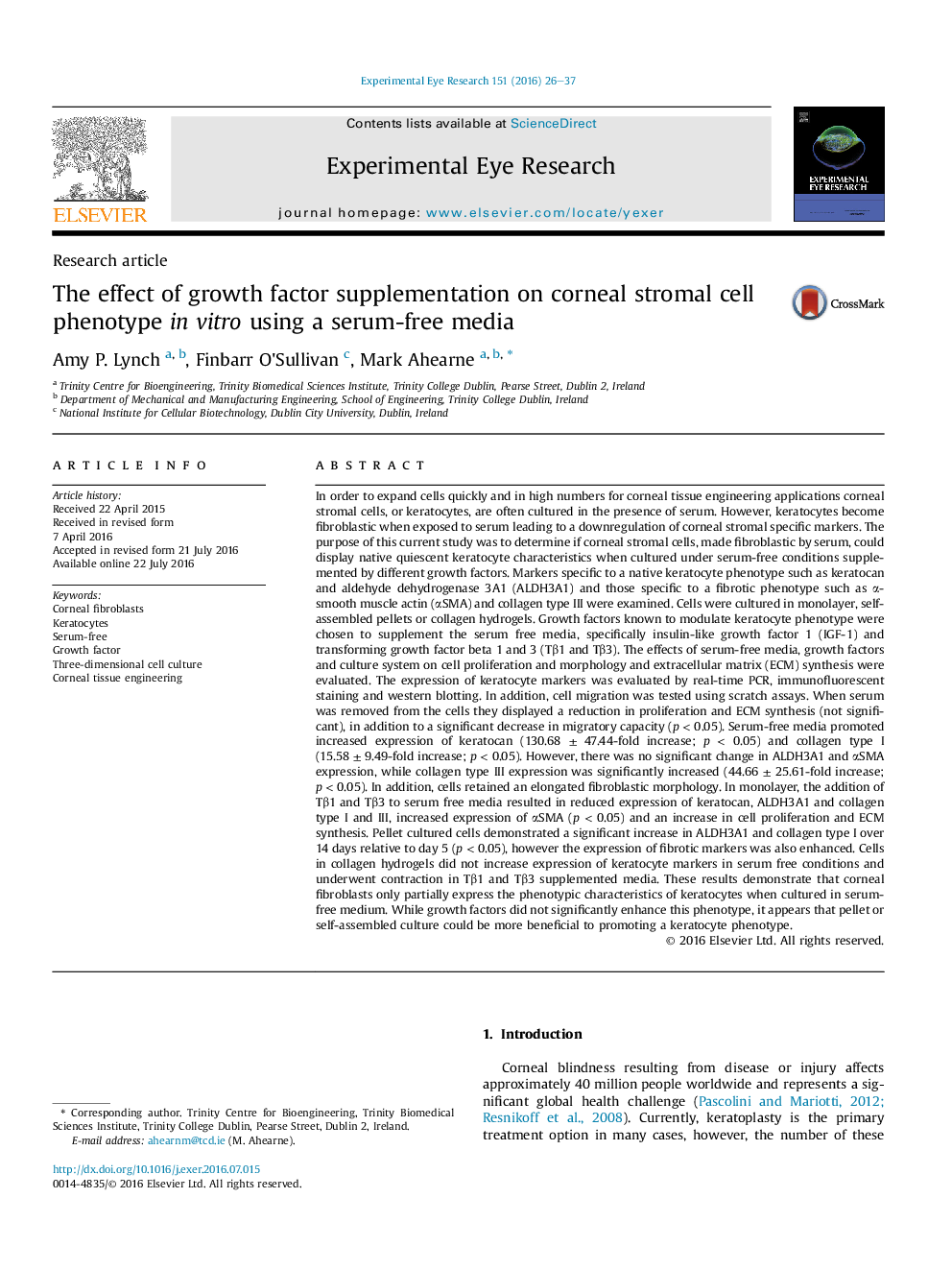| کد مقاله | کد نشریه | سال انتشار | مقاله انگلیسی | نسخه تمام متن |
|---|---|---|---|---|
| 6196178 | 1602571 | 2016 | 12 صفحه PDF | دانلود رایگان |

- Corneal fibroblast can only partially regain a keratocyte phenotype in serum-free medium.
- Growth factor supplementation provides minimal benefit for promoting a keratocyte phenotype.
- 3-D culture environments are more conducive to maintaining a keratocyte phenotype.
In order to expand cells quickly and in high numbers for corneal tissue engineering applications corneal stromal cells, or keratocytes, are often cultured in the presence of serum. However, keratocytes become fibroblastic when exposed to serum leading to a downregulation of corneal stromal specific markers. The purpose of this current study was to determine if corneal stromal cells, made fibroblastic by serum, could display native quiescent keratocyte characteristics when cultured under serum-free conditions supplemented by different growth factors. Markers specific to a native keratocyte phenotype such as keratocan and aldehyde dehydrogenase 3A1 (ALDH3A1) and those specific to a fibrotic phenotype such as α-smooth muscle actin (αSMA) and collagen type III were examined. Cells were cultured in monolayer, self-assembled pellets or collagen hydrogels. Growth factors known to modulate keratocyte phenotype were chosen to supplement the serum free media, specifically insulin-like growth factor 1 (IGF-1) and transforming growth factor beta 1 and 3 (Tβ1 and Tβ3). The effects of serum-free media, growth factors and culture system on cell proliferation and morphology and extracellular matrix (ECM) synthesis were evaluated. The expression of keratocyte markers was evaluated by real-time PCR, immunofluorescent staining and western blotting. In addition, cell migration was tested using scratch assays. When serum was removed from the cells they displayed a reduction in proliferation and ECM synthesis (not significant), in addition to a significant decrease in migratory capacity (p < 0.05). Serum-free media promoted increased expression of keratocan (130.68 ± 47.44-fold increase; p < 0.05) and collagen type I (15.58 ± 9.49-fold increase; p < 0.05). However, there was no significant change in ALDH3A1 and αSMA expression, while collagen type III expression was significantly increased (44.66 ± 25.61-fold increase; p < 0.05). In addition, cells retained an elongated fibroblastic morphology. In monolayer, the addition of Tβ1 and Tβ3 to serum free media resulted in reduced expression of keratocan, ALDH3A1 and collagen type I and III, increased expression of αSMA (p < 0.05) and an increase in cell proliferation and ECM synthesis. Pellet cultured cells demonstrated a significant increase in ALDH3A1 and collagen type I over 14 days relative to day 5 (p < 0.05), however the expression of fibrotic markers was also enhanced. Cells in collagen hydrogels did not increase expression of keratocyte markers in serum free conditions and underwent contraction in Tβ1 and Tβ3 supplemented media. These results demonstrate that corneal fibroblasts only partially express the phenotypic characteristics of keratocytes when cultured in serum-free medium. While growth factors did not significantly enhance this phenotype, it appears that pellet or self-assembled culture could be more beneficial to promoting a keratocyte phenotype.
Journal: Experimental Eye Research - Volume 151, October 2016, Pages 26-37